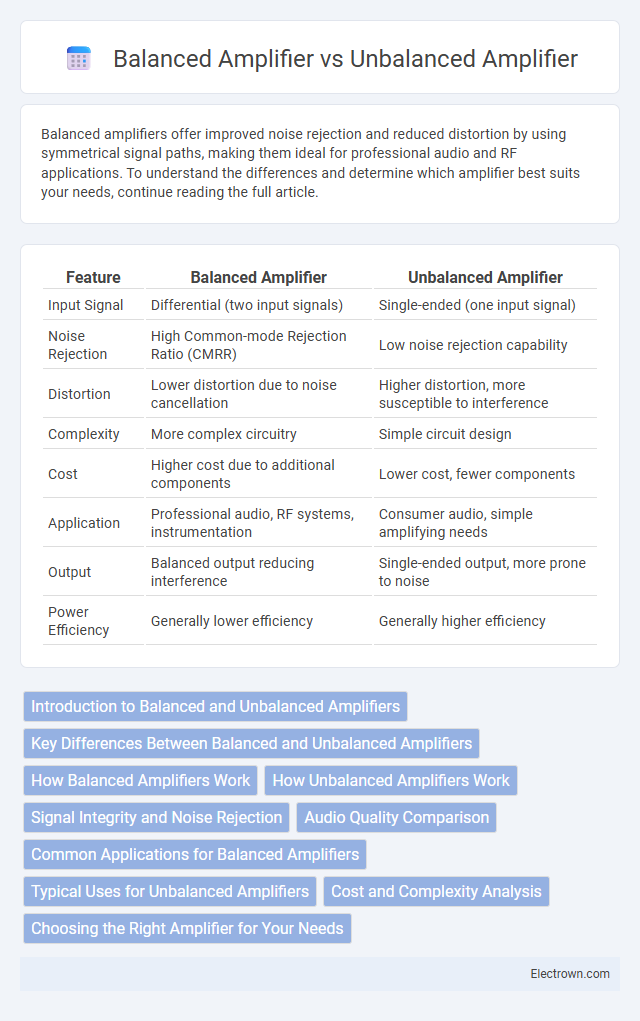Balanced amplifiers offer improved noise rejection and reduced distortion by using symmetrical signal paths, making them ideal for professional audio and RF applications. To understand the differences and determine which amplifier best suits your needs, continue reading the full article.
Table of Comparison
| Feature | Balanced Amplifier | Unbalanced Amplifier |
|---|---|---|
| Input Signal | Differential (two input signals) | Single-ended (one input signal) |
| Noise Rejection | High Common-mode Rejection Ratio (CMRR) | Low noise rejection capability |
| Distortion | Lower distortion due to noise cancellation | Higher distortion, more susceptible to interference |
| Complexity | More complex circuitry | Simple circuit design |
| Cost | Higher cost due to additional components | Lower cost, fewer components |
| Application | Professional audio, RF systems, instrumentation | Consumer audio, simple amplifying needs |
| Output | Balanced output reducing interference | Single-ended output, more prone to noise |
| Power Efficiency | Generally lower efficiency | Generally higher efficiency |
Introduction to Balanced and Unbalanced Amplifiers
Balanced amplifiers utilize two identical amplifier circuits that process signals with opposite phases, effectively canceling out noise and improving signal integrity, making them ideal for high-frequency or long-distance applications. Unbalanced amplifiers operate with a single-ended input and output, making them simpler and more cost-effective but more susceptible to external electromagnetic interference. The choice between balanced and unbalanced designs depends on the application's requirements for noise rejection, complexity, and signal quality.
Key Differences Between Balanced and Unbalanced Amplifiers
Balanced amplifiers use two signal paths with opposite polarities to reduce noise and improve signal integrity, while unbalanced amplifiers rely on a single signal path and ground reference, making them more susceptible to interference. Balanced designs typically offer better phase noise rejection and higher common-mode rejection ratio (CMRR), making them ideal for professional audio and RF applications. Unbalanced amplifiers are simpler, cost-effective, and common in consumer electronics, but their noise performance is generally inferior to balanced counterparts.
How Balanced Amplifiers Work
Balanced amplifiers operate by using two identical amplifier circuits that amplify the positive and negative halves of an input signal separately, effectively canceling even-order harmonics and noise. This differential amplification results in improved linearity, reduced distortion, and enhanced common-mode noise rejection compared to unbalanced amplifiers. The balanced design is particularly advantageous in RF and audio applications where signal integrity and noise immunity are critical.
How Unbalanced Amplifiers Work
Unbalanced amplifiers operate by using a single signal path referenced to a common ground, making them simpler and more cost-effective for low-frequency applications. The input signal is amplified directly without phase inversion, which can lead to increased susceptibility to noise and interference compared to balanced configurations. Your choice of amplifier depends on the importance of noise rejection and signal integrity in your specific audio or RF system.
Signal Integrity and Noise Rejection
Balanced amplifiers excel in signal integrity by employing differential inputs and outputs that reduce electromagnetic interference and crosstalk, resulting in cleaner signal transmission. Their inherent noise rejection capability stems from the cancellation of common-mode noise, enhancing performance in electrically noisy environments. Unbalanced amplifiers, while simpler and often more cost-effective, lack this noise cancellation feature, making your signals more susceptible to interference and potential degradation.
Audio Quality Comparison
Balanced amplifiers offer superior audio quality by minimizing noise and interference through differential signal transmission, resulting in clearer and more accurate sound reproduction. Unbalanced amplifiers typically suffer from higher susceptibility to electromagnetic interference, which can introduce unwanted hum and distortion in your audio output. Choosing a balanced amplifier enhances dynamic range and fidelity, ensuring a cleaner and more immersive listening experience.
Common Applications for Balanced Amplifiers
Balanced amplifiers are commonly used in professional audio equipment, radio frequency transmission, and telecommunications due to their superior noise rejection and signal integrity. These amplifiers excel in environments with high electromagnetic interference, making them ideal for maintaining audio clarity and data accuracy in long cable runs or complex electronic systems. Your sound systems or communication devices benefit from balanced amplifiers by delivering cleaner, more reliable signals compared to unbalanced configurations.
Typical Uses for Unbalanced Amplifiers
Unbalanced amplifiers are commonly used in consumer audio equipment, such as home stereos and portable devices, due to their simplicity and cost-effectiveness. They are ideal for short-distance signal transmission where interference is minimal, like connecting a CD player to an amplifier. Typical applications include headphones, single-ended tube amplifiers, and low-cost audio systems that do not require advanced noise rejection.
Cost and Complexity Analysis
Balanced amplifiers generally involve higher cost and complexity due to their need for matched components, additional circuitry, and precise impedance balancing to minimize distortion and interference. Unbalanced amplifiers offer a simpler design and lower production costs, making them suitable for less demanding applications where budget and simplicity are priorities. Your choice depends on whether the improved performance of balanced amplifiers justifies the increased expense and design intricacies in your specific use case.
Choosing the Right Amplifier for Your Needs
Balanced amplifiers offer superior noise rejection and signal integrity, making them ideal for professional audio environments or applications requiring long cable runs. Unbalanced amplifiers are simpler, more cost-effective, and appropriate for shorter distances or less critical sound systems. Your choice should depend on the specific requirements of your setup, including noise sensitivity, budget, and the complexity of your audio network.
Balanced Amplifier vs Unbalanced Amplifier Infographic

 electrown.com
electrown.com